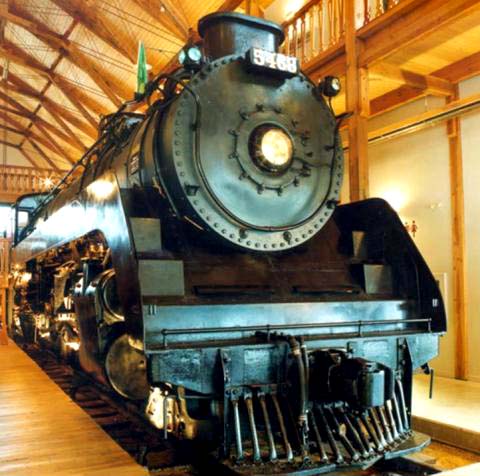
25 October 2010
Marquee B.C. Railway Museum Readies for 125th Anniversary of Last Spike

Canadian Pacific 2-8-2 Mikado number 5468 inside the Revelstoke Railway Museum.

Revelstoke British Columbia - One hundred and twenty-five years after the Last Spike was driven
for the Canadian Pacific Railway, train and history buffs will trek to the British Columbia interior to see the spot where the country connected, both
physically and symbolically.
While the spot itself is little more than a tourist stop on the Trans-Canada Highway, the site is operated by the Revelstoke Railway Museum, a facility located
about 30 kilometres away that draws more than 20,000 visitors each year.
 The museum, which features a decades-old steam locomotive and a simulator that lets guests take to the engineer's seat, lures visitors from all over the world
to the 7,500-person community.
The museum, which features a decades-old steam locomotive and a simulator that lets guests take to the engineer's seat, lures visitors from all over the world
to the 7,500-person community.
"We see people from, of course, all over Canada and the United States, but we also get people from England and Germany, and we get quite a few even from
China and various European countries," said Jennifer Dunkerson, the railway museum's executive director.
"They come from all over. It's quite interesting to look at our guestbook, actually."
The museum opened in 1994, six years after the Revelstoke Railway Heritage Society was founded.
Its purpose, Dunkerson said, is to collect and preserve the heritage of the Canadian Pacific Railway.
The museum serves as a link to B.C.'s past, since the westernmost province was lured into Confederation by the promise of the trans-Canada railway.
On one of the facility's walls, guests will find an image of former Canadian Pacific Railway director Donald Smith driving the Last Spike in Craigellachie,
B.C., on the morning of 7 Nov 1885.
It took Smith, far from an accomplished layer of track, two attempts to correctly hammer the spike.
His first swing did little more than bend the five-inch piece of iron.
When his second attempt succeeded, those in attendance broke into cheers.
"The driving of the Last Spike... symbolically and physically connected the country from sea to sea, as promised as part of the Confederation
process," Dunkerson said.
That point was seconded by Don Evans, president of the West Coast Railway Association, a Vancouver-based non-profit group that works to preserve B.C.'s railway
heritage.
Evans said the history of the province would be much different if the railway hadn't been completed.
"The significance of the story is as big as British Columbia's choice to join Canada instead of the U.S.," he said.
The Last Spike is today kept in the Canada Science and Technology Museum in Ottawa.
To mark the 125th anniversary of the Last Spike, Canadian Pacific Railway's 2816 Empress steam train toured a number of communities this past summer.
While a railway spokesperson declined to be interviewed, so as not to spoil the surprises the company has in store for the anniversary, Dunkerson said a number
of activities are planned.
"(We're) working to put on an event that would have some political representation and dignitaries," she said, adding Parks Canada and the Ministry of
Transportation are also part of the planning.
"There will be about half an hour of some special presentations and speeches on site, as well as an opportunity for people to see the monument on site
that's been restored."
The museum itself is open year-round, though hours are reduced in the winter months. Adult admission is $10, while seniors pay $8 and youths pay up to $5.
Dunkerson said the museum's biggest draw is its steam locomotive.
"5468 is its number and it was built in Montreal... purposely for mountain work, for the strength required in hauling freight trains through the mountains
in the 1940s," she said.
"It's basically our gem, the one that attracts the most attention."
The museum also features box cars from other trains, as well as a caboose.
The museum also runs a store and the attractions at the Craigellachie site. That store typically closes at the end of August, but Dunkerson said it will be
open on the anniversary date.
When asked if the Last Spike still has the relevance among the public it once did, Dunkerson said yes and no.
"When it comes to a lot of the people who are very much involved with the railway and the mountain culture out here, it's still a very big part of the
story, very significant," she said.
"I think there are other parts of Canada that may have forgotten that connection but those of us out here, it still resonates pretty strongly."
Evans said much the same.
"There's a tremendous amount of railway preservation in Canada. There's many, many, heritage operations out here on the West Coast," he said,
pointing to groups in Kamloops, Prince George, and Cranbrook, just to name a few.
"Where perhaps it's not quite so solid is as you get into the younger generations. And as those of us that grew up where railways were a key piece of our
everyday lives, they're less so now."
"They're not as front of mind as they would have been 50 years ago."
Sunny Dhillon.

|